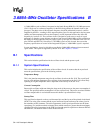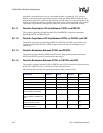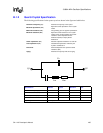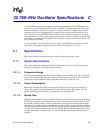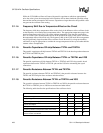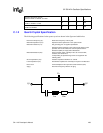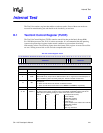
434 SA-1110 Developer’s Manual
3.6864–MHz Oscillator Specifications
Note that in some applications, such as a system that includes a socketed SA-1110, it may be
difficult to meet the parasitic capacitances specified. While the 3.6864-MHz oscillator will start
with parasitic capacitances, which are approximately twice the values given, the startup time in this
situation will be about double the specified startup time and the current consumption will increase.
Capacitances larger than twice the specified values may prevent the oscillator from starting.
B.1.1.1. Parasitic Capacitance Off-chip Between PXTAL and PEXTAL
The parasitic capacitance off-chip between PXTAL and PEXTAL is the board capacitance
between the PXTAL and PEXTAL pins.
B.1.1.2. Parasitic Capacitance Off-chip Between PXTAL or PEXTAL and VSS
The parasitic capacitance off-chip between PXTAL or PEXTAL and VSS is the parasitic board
capacitance between the PXTAL or PEXTAL pins and the VSS wire surrounding the crystal
connections.
B.1.1.3. Parasitic Resistance Between PXTAL and PEXTAL
The parasitic resistance between PXTAL and PEXTAL is the parasitic resistance between the
PXTAL and PEXTAL pins due to moisture and other effects.
B.1.1.4. Parasitic Resistance Between PXTAL or PEXTAL and VSS
The parasitic resistance between PXTAL or PEXTAL and VSS is the parasitic resistance between
the PXTAL or PEXTAL pins to VSS due to moisture and other effects.
The following table describes the system specifications of the oscillator circuit.
Specification Minimum Typical Maximum Unit
Temperature range 0 100
o
C
Supply voltage 3 3.3 3.6 V
Ripple voltage on the supply ——0.3 V
Current consumption — 15 40 µA
Startup time — 15 150 ms
Parasitic capacitance off-chip
between PXTAL and PEXTAL
——1
pF
Parasitic capacitance off-chip
between PXTAL or PEXTAL and
VSS
—
— 2
pF
Parasitic resistance between
PXTALorPEXTALtoVSS
1 ——MΩ
Parasitic resistance between
PXTAL and PEXTAL
1 ——MΩ










